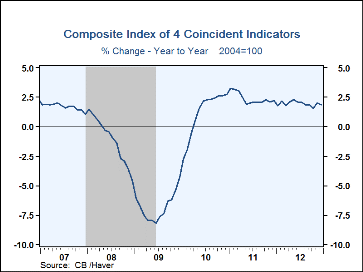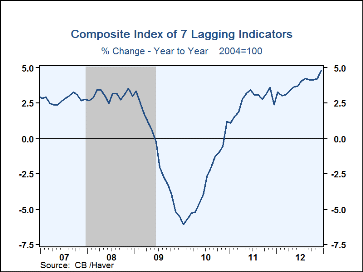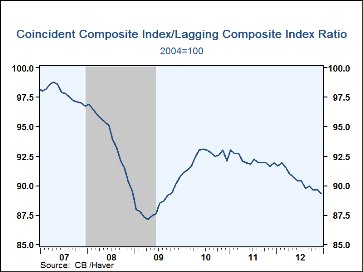 Global| Jan 24 2013
Global| Jan 24 2013U.S. Leading And Coincident Economic Indicators Slow
by:Tom Moeller
|in:Economy in Brief
Summary
During all of last year, the Leading Economic Indicator index from the Conference Board grew 2.0%, down from 5.1% and 8.0% increases during the prior two years. Last month, the leaders rose 0.5% following a revised no change in [...]
During all of last year, the Leading Economic Indicator index from the Conference Board grew 2.0%, down from 5.1% and 8.0% increases during the prior two years. Last month, the leaders rose 0.5% following a revised no change in November, earlier reported as a 0.2% decline. Sixty five percent of the component series had a positive influence on the index last month, the most since July. The majority of the December increase owed to lower initial claims for unemployment insurance. A steeper interest rate yield curve, higher stock prices and the leading credit index also had positive influences on the total. These were offset by a lower ISM new orders index, fewer nondefense capital goods orders and lower consumer expectations for business & economic conditions.
Attesting to moderate economic growth, the 1.9% rise in the coincident economic indicator index during 2012 was reduced from a 2.4% increase in 2011. The index of coincident indicators increased 0.2% in December after a 0.5% November rise, revised from 0.2%. Last month, all of the component series contributed positively to the overall index rise, the largest influence coming from real personal income less transfers.
These gains are against the backdrop of building economic excess. The index of lagging economic indicators rose a quickened 3.8% last year after a 2.7% rise in 2011. During December, the series rose 0.7%, the strongest increase since April. Three-quarters of the component series rose, notably commercial & industrial loans outstanding and the average duration of unemployment.
Another leading economic series is the ratio of coincident-to-lagging indicators. It measures how the economy is performing versus its excesses. The figure fell again last month to its lowest level since September 2009.
The Conference Board figures are available in Haver's BCI database; the components are available there, and most are also in USECON. The forecast figure for the Consensus are in the AS1REPNA database. Visit the Conference Board's site for coverage of leading indicator series from around the world.
Balance of Payments in the European Periphery from the Federal Reserve Bank of San Francisco can be found here.
| Business Cycle Indicators (%) | Dec | Nov | Oct | Y/Y | 2012 | 2011 | 2010 |
|---|---|---|---|---|---|---|---|
| Leading | 0.5 | 0.0 | 0.3 | 1.8 | 2.0 | 5.1 | 8.0 |
| Coincident | 0.2 | 0.5 | 0.0 | 1.8 | 1.9 | 2.4 | 1.2 |
| Lagging | 0.7 | 0.3 | 0.3 | 4.8 | 3.8 | 2.7 | -3.1 |
Tom Moeller
AuthorMore in Author Profile »Prior to joining Haver Analytics in 2000, Mr. Moeller worked as the Economist at Chancellor Capital Management from 1985 to 1999. There, he developed comprehensive economic forecasts and interpreted economic data for equity and fixed income portfolio managers. Also at Chancellor, Mr. Moeller worked as an equity analyst and was responsible for researching and rating companies in the economically sensitive automobile and housing industries for investment in Chancellor’s equity portfolio. Prior to joining Chancellor, Mr. Moeller was an Economist at Citibank from 1979 to 1984. He also analyzed pricing behavior in the metals industry for the Council on Wage and Price Stability in Washington, D.C. In 1999, Mr. Moeller received the award for most accurate forecast from the Forecasters' Club of New York. From 1990 to 1992 he was President of the New York Association for Business Economists. Mr. Moeller earned an M.B.A. in Finance from Fordham University, where he graduated in 1987. He holds a Bachelor of Arts in Economics from George Washington University.










